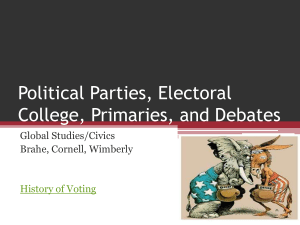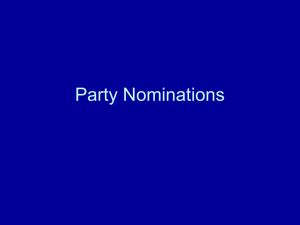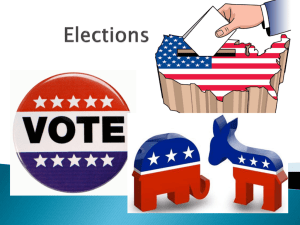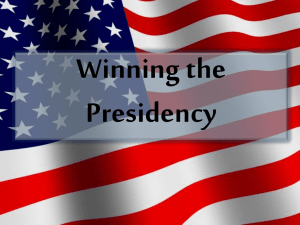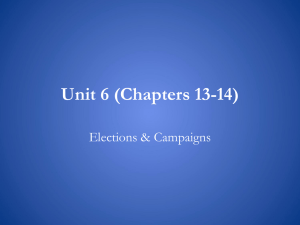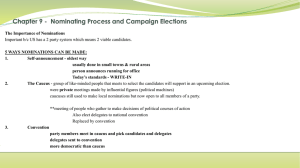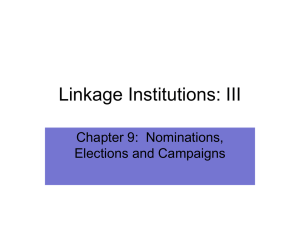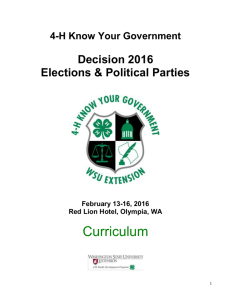Ch.9, 10, 14: Running For President
advertisement
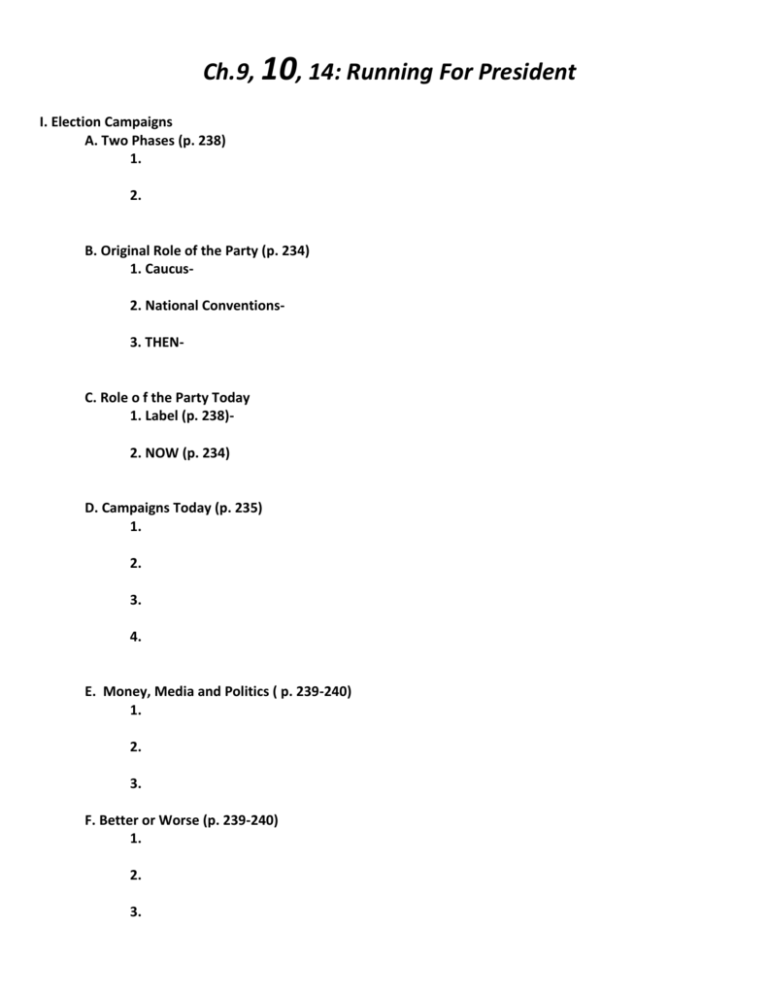
Ch.9, 10, 14: Running For President
I. Election Campaigns
A. Two Phases (p. 238)
1.
2.
B. Original Role of the Party (p. 234)
1. Caucus2. National Conventions3. THEN-
C. Role o f the Party Today
1. Label (p. 238)2. NOW (p. 234)
D. Campaigns Today (p. 235)
1.
2.
3.
4.
E. Money, Media and Politics ( p. 239-240)
1.
2.
3.
F. Better or Worse (p. 239-240)
1.
2.
3.
II. Getting Nominates (p. 239-240)
A. Getting Mentioned (p. 239)
1.
2.
B. Time Commitment/Unemployed or Underemployed (p. 239)
1.
2.
3.
*C. Outsider?
1.
2.
* D. Qualifications
Constitutional:
Personal:
Politically:
Other:
E. Money (p. 240)
1.
2.
F. Organization(p. 240)
1.
2.
G. Strategy and Themes/Four T’s (p. 240)
1.
2.
III. Road to Nomination (p.214-6, 225-227)
* A. Primaries1.
2.
B. Dilemma of Party/Two Contrary Forces (p. 225)
1.
2.
C. Obtaining Delegates
1. Delegates per State/Formula (p. 214-215)a.
b.
2. Choosing Delegates (p. 215)a.
b.
3. Superdelegates-(p. 215)
a.
D. Primaries v. Caucuses (p.246, 226)
1. Choosing Delegates(p.216)a.
b.
2. Primariesa. Open Primaryb. Closed Primaries
3. Caucus (p. 226)E. Iowa and New Hampshire (p.243-244)
1. Iowa
a.
b.
*2. New Hampshire
F. National Convention
1. Purpose (3 things)
a.
IV. Delegates v. Voters-The Problem with the Nominating Process
A. Primary v. General Election
1. Primaries-to win the primary you must appeal to your base and win the initial states
a. Early in primaries are extremely important: winning the Iowa Caucus and New Hampshire Primary
brings in money and political support
b. Primary voters are more conservative and liberal than average voter
c. Once primary is won, candidate must get back to middle as soon as possible and try to be able to
respond to opponent’s use of radical rhetoric
B. . Are the Delegates Representative of the Voters? (p. 225)
1.
2.
C. Who Votes in Primaries? (p. 226)
1.
2.
D. Who are the New Delegates (p. 226-227)
1.
2.
E. Parties v. Voters (p. 229)
1.
2.
V. Electoral College (p. 376-377)
A. Essential Facts
1. Per State2. Total
3. 23rd Amendment-gave Washington D. C. resident 3 electoral votes
B. Electors Assemble1.
2. Faithless Electors
C. Role of House
1.
2.
D. Winner-Takes All-System
1.
2. Maine and Nebraska-
E. Small State Advantage
1.
2.
F. Reform
1.
2.
*G. 2000 Election (Cliff hanger, The role of 3rd parties, Florida Vote Controversy, the Supreme Court)
1.
2.
3.
VI. To the Polls Ye Sons of Liberty Packet
A. Constitutional Convention
1.
2.
3.
B. Original System
1.
2.
3.
C. 1st Election
1.
2.
D. Mute Tribune
1.
E. Rise of Parties
1.
2.
F. Crisis of 1800
1.
2.
G. Vote in the House
1.
2.
H. 12th Amendment
1.
I. States Choosing Electors
1.
2.
J. Winner Takes All System-winner takes all system in which candidate who wins popular vote in state
wins all their electoral votes
1.
2.
K. 1824 Election
1.
2.
L. 1868 Election
1.
2.
M. Stumbling Block or Safeguard?
1.
2.
*VII. General Election
A. General Election
1. To receive a party’s nomination you need ideologues, the moderate to win the general
a. Moderates lose in primary although they might do better in general
b. {--------------------|----------------------}
Liberal
Conservative
B. Strategy for Choosing a Vice President
1.
2.
C. Swing States
1.
2.
D. Swing Voters
1.
2.
E. Sleeping Giant
1.
2.
F. Base/Issues
1.
2.
G. Issues (p. 244-246)
1.
2.
H. Image-perception is reality in politics
1.
2.
VIII. Television, Debates, and Direct Mail (p. 246--249)
A. Whistle Stops1.
B. Television
1.
2.
C. Spots-little known candidate can increase his/her visibility through spots
1.
D. Visuals-are a vital part of campaigns because unlike spots they do not cost any money and save vital
resources
1.
E. TV Debate
1.
F. Slips/Gaffes1.
2.
G. Direct Mail
1.
IX. Financing Election Campaigns (p. 249-256)
A. Money-powerful CA Congressman once observed that “money is the mother’s milk of politics.”
1.
B. Source of Money1. presidential candidates get half from private donors and half from government
a. matching money is limited, in 1996 it was $61.8 million
2.
C. Campaign Finance Rules-designed to level the playing field
1.
2.
D. Matching Funds
1.
2.
E. Independent Expenditures –does not limit amount that is spent opposing a candidate so as long as this
spending was “independent’ or not coordinated with the opposing candidate’s campaign
1. Allows for indirect support of candidate usually thru attack ads
2. Ad may tell you about individual but cannot tell you to vote for or against candidate
3.
F. Hard and soft money-donations that go directly to candidate for his/her elections
1. Hard money-is compromised of donations that go directly to candidate for his/her elections
a. Regulated money that FEC is in control of
b. Must be publicly disclosed quarterly
2. Soft money-expenditures given to party organizations that are supposed to be used for party
building; staff, computers, issue ads, get us to vote campaigns
a. Unregulated money that FEC has no control of
G. McCain/ Feingold Bill (Bipartisan Campaign Finance Reform Act of 2009)
1. principles-passed in 2000 by bi-partisan effort and is established on 3 guiding principles
a.
b.
c.
2. Soft Moneya.
3. Hard Moneya.
4. Independent Expenditures-were to be heavily restricted
a.
H. New Sources of Money
1.. We now have 527 ads that operate outside scope of these laws
2.
I. Landmark Financing Elections Rulings
1. Buckley v. Valeoa.
2. McConnell v. FECa.
3. FEC v. Wisconsin Right to Life Inc.a.
4. Citizens United v. FECa.
X. What Decides an Election? (p. 256-264)
A. Money and Winning
1.
2.
B. Vice President
1.
C. Religion
1.
D. Abortion
1.
E. Party
1.
2.
F. Issues
1.
2.
3. Prospective Votinga.
4. Retrospective Votinga.
XI. The Campaign (p. 260--262)
A. Party loyalty
1.
2.
B. Handling Pressure
1.
2.
C. Character and Values
1.
2.
D. Finding a Winning Coalition
1.
XII. Effects of Elections on Policy (p. 264-266)
A.
1.
2.
B.
1.
2.
C.
1.
2.
D.
1.
2.

